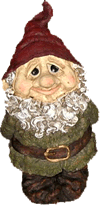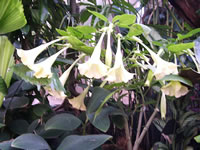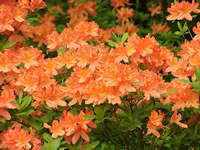They are used as screens, backgrounds and accents. Trees are used for shade and for fruit. Flowering shrubs provide long lasting, beautiful blooms which brighten even the gloomiest of days.
Because the cultural needs, size, and structure can vary so greatly, even within different varieties of the same species of trees and shrubbery, I recommend visiting a local botanical garden or arboretum before deciding on your choices. Even a leisurely stroll through your own neighborhood will provide you with a great deal of insight into what you like, and what grows well in your area. Trees and shrubs live and grow for many years, so the effort it takes to make an informed choice is well worth the time that it takes.
Botanical Name: Brugmansia
Height: 6-12 ft.
USDA Zones: 9-12
From early summer until fall, mature Angel's Trumpet's produce waves of large, very fragrant, downward hanging, trumpet shaped, 6"-10" long flowers. In frost free regions, they may bloom all year long.
Botanical Name: Rhododendron
Height: 1-8 ft.
USDA Zones: 6-8
Azaleas
must be grown in an
acid soil, with a pH of 5.0 to 6.5. The buds for next years blooms will be formed this year, so it important that the faded blooms are removed
Botanical Name: Callicarpa bodinieri
Height: 6-8 ft.
USDA Zones: 6-8
Beautyberry grows to a height of 6-8 feet. The foliage is a beautiful bronze color as it emerges in spring. Small lavender flowers in mid-summer produce clusters of intensely purple berries in the Fall
Botanical Name: Caryopteris clandonensis
Height: 2-3 ft.
USDA Zones: 5-9
Bluebeard plants are low growing shrubs that are covered with fragrant, blue flowers in late summer and early fall. The silvery green, 1"-2" leaves have a light aroma of Eucalyptus when rubbed. Bluebeard flowers are a favorite
food for butterflies and bees.
Botanical Name: Buddleia davidii
Height: 6-15 ft.
USDA Zones: 5-10
The Butterfly Bush is a fast growing, profuse blooming, deciduous shrub that will grow in almost any type of soil. Prune hard in early spring and remove spent flowers promptly.
Botanical Name: Gaura lindheimeri
Height: 2-4 ft.
USDA Zones: 5-10
Butterfly Gaura are shrubby, perennial
wildflowers that are closely related to the
Evening Primrose. From late spring until first frost, they produce 8"-24" spikes of 1" flowers that are white when they open at dawn and fade to rose-pink as the sun sets.
Botanical Name: Camellia
Height: 2-3 ft.
USDA Zones: 7-10
Camellias are long lived evergreen shrubs or small trees that can grow anywhere from 6-20 feet tall with up to a 10 foot spread, depending on the species and cultivar. They have glossy, dark green, 2"-4" foliage that is attractive even when the plant is out of bloom. The flower colors range from pure white to deep, dark red and there are even some bi-colored varieties.
Botanical Name: Hamamelis mollis
Height: 10-15 ft.
USDA Zones: 5-9
Witch Hazel is a low maintenance deciduous shrub which is one of the earliest blooming shrubs, providing you with lots of showy, fragrant flowers beginning in early February
Botanical Name: Potentilla fruticosa
Height: 2-3 ft.
USDA Zones: 2-7
Potentillas prefer well-drained, reasonably rich soil, but will tolerate clay, rocky, or even
slightly alkaline soils as well. Loads of pink or yellow 'buttercup' flowers in June.
Botanical Name: Cotoneaster
Height: 3"-15 ft.
USDA Zones: vary
Cotoneaster is an extremely diverse genus of plants which includes ground covers, dwarf sized bushes and large sprawling shrubs. The flowers are generally small and appear from spring to early summer followed by bright red or orange berries for the birds to eat in winter.
Common Name:
Coyote Brush
Botanical Name: Baccharis pilularis
Height: 2-3 ft.
USDA Zones: 7-10
Coyote Brush is a fast growing evergreen shrub with small, bright green leaves. It blooms from July through October with clusters of tiny flowers. The male flowers are yellow, female flowers are white
Botanical Name: Sambucus
Height: 10-20 ft.
USDA Zones: 4-10
Elderberries are fast growing, low maintenance, multi-stemmed deciduous shrubs with deeply veined, serrated foliage. They produce large flat clusters of flowers in late spring to early summer, followed by small berries which may or may not be poisonous, by species
Botanical Name: Rhododendron
Height: 4-12 ft.
USDA Zones: 5-9
Deciduous Exbury Azaleas bloom in late spring or early summer, producing clusters of 7-18 large, 2"-3", often very fragrant, often bi-colored flowers in shades of yellow, orange, pink, red and white.
Botanical Name: Prunus blireiana
Height: 15-20 ft.
USDA Zones: 5-9
Flowering Plums seldom produce fruit due to a lack of pollinators when they bloom, but the dark purple plums are edible. The fragrant, one inch, pink flowers appear in early spring followed by purple foliage which turns green by mid-summer
Botanical Name: Chaenomeles speciosa
Height: 3-10 ft.
USDA Zones: 4-8
Flowering Quince is a twiggy, rounded upright deciduous shrub. The 1" foliage opens to a beautiful reddish bronze color before turning dark green by mid summer. Showy cup shaped flowers cover each stem in the spring before turning to an edible fruit by summers end
Botanical Name: Ribes sanguineum
Height: 6-10 ft.
USDA Zones: 5-8
Botanical Name: Gardenia jasminoides
Height: 6 ft.
USDA Zones: 9-10
Gardenias should be planted in well conditioned soil containing peat moss and
compost. Keep the soil moist, cool and weed free. Proper temperatures are necessary for a gardenia to bloom. May be
grown as a house plant
Botanical Name: Forsythia
Height: 1-10 ft.
USDA Zones: 4-9
One of the earliest signs that spring has arrived, is when the Forsythia bursts into a profusion of yellow blossoms spreading from the ground to the tip of each graceful, cascading branch. Forsythias will grow in almost any soil or growing condition














